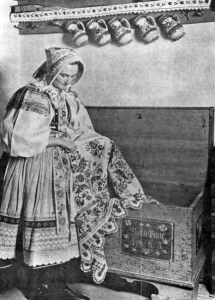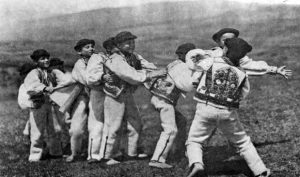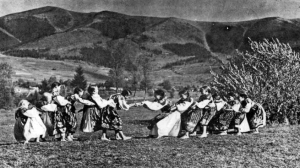Part I: Old World Origins
Socio-Economic Conditions
Up to the turn of the 20th century Slovakia was an agrarian nation with 90% of its population tilling the land. Only the clergy were the educated class apart from a few others who came from wealthier or better placed families like the gentry. Therefore, throughout much of their history the Slovak people had to look to their priests and ministers for leadership in public and civic life as well as in church matters.
Economic Inequities
While the Slovak population was growing, the arable land was not keeping pace with this growth. The Kings of Hungary (and after the 15th century the Emperors of Austria and Hungary) had sought to protect peasant land by guaranteeing its inviolability in 1767, but not before the Hungarian gentry had managed to absorb much peasant acreage. Thus, we have a condition where nobles owned more than 90% of all arable land, allowing serfs (peasants in bondage) to work it only as sharecroppers. When the serfs were finally freed in 1848, their lot improved very little. They received only those holdings which their forefathers had worked in 1767. As a result, peasants and former serfs, who made up 90% of the population, owned less than half the arable land while the gentry, a tiny minority, owned the other half.
What solutions could have helped the plight of the Slovak peasants? There were three — land reform, industrialization or emigration. Had the revolution of 1848, which freed the serfs, also resulted in the confiscation of noble land and its redistribution among the peasants, the economic situation of the vast majority would have improved. However, since Hungarian nobles had led the Revolution of 1848, they could hardly have been expected to redistribute their own land. After the Revolution collapsed, they made no attempts at land reform and the majority of the peasants continued working less than five acres per family, plots too small to support a family of four.
Industrialization offered another solution, but one which Hungary was loath to accept. Unlike Western European countries, including the Austrian half of the Empire, Hungary was slow to industrialize in the 19th century. The blame can be laid again at the feet of the nobility who regarded country life as the highest form of existence and who despised industry as “unbecoming” of gentlemen. As a result, while the rest of Europe industrialized in the late 19th century, Hungary remained an agricultural backwater and the desperate peasants could not find enough work even to pay their taxes. Thus, leaving the management of their little farms to the other members of the family, the man of the house had either to find a job working for the Hungarian nobles, or he had to find a livelihood in other parts of the world.
Immigration
Finding a livelihood in other parts of the world was almost a way of life for the Slovaks. As their population increased from 1,000,000 to over 2,400,000 between 1700 and 1830, more than 200,000 of the landless peasants migrated to the lowlands of the Banát and Bačka (today in Yugoslavia) where they began to farm land that had only recently been recovered from the Turks. More than 50,000 also moved to Vienna to find work while, by 1870, over 20,000 left yearly to wander allover Europe as “tinkers” — handymen who offered to fix household implements for a small fee. In addition, several hundred thousand found seasonal employment on noble land, especially during the harvest season in 19th century Hungary. Since so many Slovaks were already on the move before 1870, it remained only a matter of time before they extended their wanderings to America.
Food Diet
The Slovak population was almost exclusively vegetarian. Meat was a luxury only to be had on Sundays and on special occasions such as Christmas, Easter, and at weddings and christenings. The vegetables they were able to grow provided the main courses from whence many of their regional dishes were created. Potatoes were particularly versatile, and today Slovaks still enjoy “halushki” (potato dumplings smothered with fried buttered sweet cabbage or cottage cheese), “pirohi” (a dough-dumpling filled with mashed potatoes, sauerkraut, lekvar, or cottage cheese) and “loksha” (crepe-like potato-pancake brushed with melted butter). If, and when meat was to be had, it was either poultry or pork. Every edible part of the pig was utilized. The fat and rind of the pig were rendered and crushed into little bits called “shkvarki” and these were used to flavor biscuits. For “holubki” these bits of pork rind (a far cry from the ground meat that is used in stuffed cabbage today) were mixed with the rice. Even the feet of the pig were cooked and made into a gelatin-like dish called “studenina.” There were variations of these dishes in the various locales, but the above-mentioned dishes should be recognizable to any Slovak from Zemplin, an eastern district from whence many of the first immigrants came.

Home Life
The Slovak people often had little of the goods of this earth but they did not covet material riches. The simple cottage that enfolded all the family often had only a dirt floor, but its walls were whitewashed and gaily painted indoors and out with original peasant designs that displayed the creative talent and taste of each family group. Colorful embroideries distinguished not only the wearing apparel of every person in the home, but also graced many details of the interior — the bed linens and coverlets, hangings at the windows and from the shelving in the kitchen, tablecloths, and even shrouds. Peasant painting adorned ceramic ware in the kitchen, and exquisite carving lent a distinctively artistic quality even to rather commonplace objects like kitchen utensils, door frames, cottage gables and balconies, a smoking pipe, a toy, a grave marker or wayside cross, a shepherd’s flute, a cradle. In sincere appreciation of the artistry of these creations, the poet Sládkovič observed, “Look at the dipper of our herdsmen, and you will dream of Phidias.”
The daily life of the Slovak people was basically rooted in spiritual and religious principles. Devotional practices were part of everyday tasks and experiences. In a typical Slovak home the day began and ended with prayer. Daily chores and interests were punctuated with spontaneous aspirations to God, reverent sighs calling on Him for help and support. The knife that is to cut a fresh loaf of bread first traces the sign of the cross upon it. On entering a home or putting on a light, one first praises God’s holy name: “Praised be Jesus Christ!”


The most prominent ornaments on the walls of a cottage have always been the crucifix and sacred images. Often a blessed pussy willow branch, reserved from the previous Palm Sunday, had a place among these, and, in the event of a violent storm, a blessed candle was lighted in prayer and a bit of the blessed branch was burned in petition for safe keeping against the storming elements of nature. A stoup of holy water hanged at the doorpost so that those who entered or left could dip their fingers and bless themselves in traditional Christian fashion.
The family rosary has been a common practice. Pilgrimages, processions, and church services brightened a holiday or a holy day. A prayer book and the beads were cherished personal possessions. Lenten practices were observed conscientiously, all entertainment and frivolity being strictly banned in the penitential season. Religion permeated all the experiences of life.
Song and Music
Almost as close to their lives as religion was the Slovak fondness for song and music. Even today singing is part of the nature of Slovak people. The poet-scholar Miloš K. Mlynarovič sees in song a sustaining art in the lives of the Slovaks. It is their natural way of communing with God and becoming inwardly renewed.
Nature’s richness is the inspiration for the countless songs that he sings as he delights in the towering mountains, and the shaded valley, the full grown tree and the little budding flower, the forces of wind, storm, and stream as well as the glory of the new-born day. He has a song for every occasion, songs of joy and love at weddings, historic ballads, ritual melodies, songs of the Janošík mountain boys, songs that express his toils and griefs, his recreation and festivals, dancing songs, war songs, and midsummer songs for special gatherings around the great bonfires on special summer evenings.
The profusion of Slovak folk songs is incredible. The Institute of Slovak Folk Songs at the Slovak University at Bratislava has collected and prepared for publication 10,000 of these songs and work goes on researching in many more villages and hamlets because it may be possible to gather and preserve 20,000 or more separate Slovak folk songs.
At folk song festivals sponsored in Czechslovakia between the two great wars, one year the first prize was presented to a typical peasant singer for her rendition of up to 500 folk selections. In a subsequent contest this singer again merited the first prize, this time for her offering of 700 songs.
In another vein, the Slovak people found that their difficult fate was sweetened by the joys of family life, the sharing of tales around a fireplace, the frisking of lambs in a springtime pasture, the song of the lark. Their tired spirit was often strengthened by the Christian bearing of difficulties and injustices, by the memory of their bygone glory as well as by the example of national heroes both from ancient times and from closer historic days.
